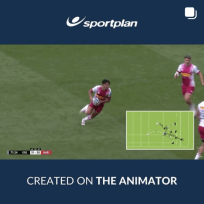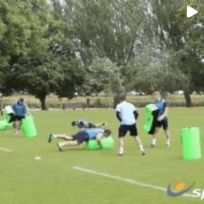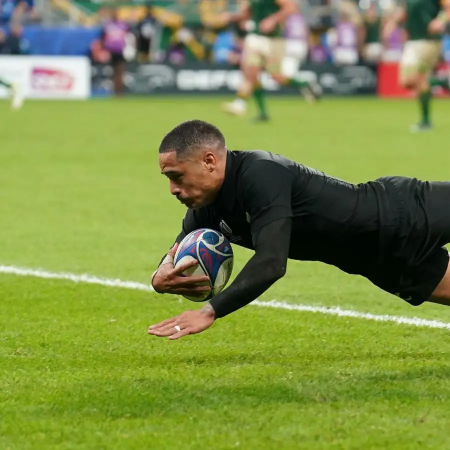TRANSFORM YOUR TEAM'S SEASON WITH PROFESSIONALLY PLANNED SESSIONS
Use our expert plans or build your own using our library of over 700+ drills, and easy-to-use tools.
JOIN NOWI will be coaching under 10 next season and need some guidance on how to interpret the rules for the maul?





There is nothing in the U10 rules about the maul moving forward, that comes later. The reason this rule is like this is to promote the pace of the game and recycling the ball quickly after a ruck/maul. If you teach your lads with your method and they go to a club where the rules are applied as written, they could be put off. My advice is stick to the laws as written.
You are absolutly right about the ball going to ground. We coach the kids that as soon as you hear the ref shout `maul` you have 5 seconds to get the ball to ground or twist and offload to a team mate.
Think of it like this: If you come up against some freak of a 6` 10 year old who can`t be stopped by 2 defenders, you will be thankful of the rule then :)
Thanks,
Antony
As soon as the 2nd attacking or defending player joins a mini maul is formed. Do the players have 5 seconds from this point to progress then the ref calls "use it"? Then how much longer have the players got to get the ball away from the contact area?
What does made available mean? Passed away from the contact area or visible and ready to be moved away from the contact area. At what point should the ref call "use it"?
Its not well worded in the rules.
I look forwaard to your help.
cheers
In our rules the ref calls use it a second after the 2nd warning for not moving then if it still doesn't move, use it or lose it scrum other team. What I found to work is if you pack your maul in a 3, 2,2, 1 formation it's unstable, but your penalty count will increase imensly. Hope I was of help!
Ezra; best to know that a maul is formed with min. 2 players from the team in possession against 1 defender. It cannot exist with 2 defenders and an attacker with the ball. When the contest is 1 v 1 there's no maul. Only when the ball carrier is joined by a team mate does the maul exist. I use a system where the ball carrier who has no choice but establish the maul steps towards the external edges of the defender, and assumes a position of feet at more or less 45 degrees. He is joined by a team mate who enters with the opposite shoulder,also at 45 degrees, thus creating a hiddeen pocket for the ball, and a situation where there are 2 body depths between opponent and ball.
From the point of view of structuring the situation; I get the ball carrier to slow up near the defender, and his support player (in the same footprints) to grasp the ball carrier's shirt at waist height. This means that in some way they anticipate the contact, so at the moment of contact the support player is already preparing his body position. On contact with the opponent they 'interlock' to secure the ball. 1 nd 2 are both then very low which allows a 3rd support player (if necessary) to add to the formation looking and driving forwards on the first ball carrier without covering the ball.
Couple of coaching ideas; to explain the idea of getting 2 body depths between the ball and the defender I have a bit of fun; defender lies on his back, 1st attacker on top, same direction (all facing same way) and 2nd attacker on top again. I then give a ball to the 2nd attacker and ask the defender to get at the ball from below! Lots of laughs...
I then propose that the ball has a laser beam inside, and they must not loose the beam that is pointing at the half back, so the attackers must keep a clear sight of the ball for the half back. To explain the offside lines creaed by the maul (and ruck for that matter) I have about 5 metres of knicker elastic that I stretch behind the maul between 2 coaches to illustrate the offside line, as the ball comes out then one coach lets go, elastic twangs away, and it's open play. I know it sounds a bit nuts, but younger rugby players love visible clues like this!
thanks fo your input on the mini maul. BTW I love the knicker elastic idea which I can see many uses for this season.
The mini maul is proving tricky to manage as only two players are allowed from each side. Wnating to give the play time to develop before calling maul often leads to more than 2 players from each side attaching to the maul so that players then have to drop off or be penalised. Not one of the best rules if I am honest and we, as a 5 strong team of level 1 coaches, will continue to refine the coaching and refereeing. I`ll feedback as the season progreses.
Rule 6.b: A "maul" is formed when the ball carrier and tackler are joined by
one additional player from either the defending or attacking team.
No more than two players from either side (including the ball
carrier and tackler) can be involved in the maul.
As soon as the maul forms the players have 5 seconds to move that ball out of the maul or get it to ground. The ref will call `Use it` to indicate that the 5 secs are up, if the ball doesn`t come out it is a scrum to the defending team.
Thanks,
Antony
Antony; have a look at Law 17 on IRB website. It doesn`t mention one additional player from either side, quote:-
"A maul begins when a player carrying the ball is held by one or more opponents, and one or more of the ball carrierâs team mates bind on the ball carrier."
The essential element therefore is the second part of the statement after `and`....
Hi Andrew
The original question relates to U10 and Antony is correct in this respect.
You are probably correct for other age groups.
@Eamonn: Thanks for the support :)
I can only add that for U11`s (where I ref now) this deffinition has changed to:
8.b. A "maul" is formed when the ball carrier and tackler are joined by two additional players from either the defending or attacking team.
No more than 3 players from either side (including the ball carrier and tackler) can be involved in the maul.
Why on earth this can`t be the standard IRB rule 17 that @Andrew rightly mentions, I have no idea?!
Thanks,
Antony
@Ezra: In respect of getting the kids to not break the rules, I find a nice loud shout of "Numbers Team X" as a warning, followed by whistle and free pass to the team infringing if they don`t sort it out pronto.
You must call a maul as soon as one exists, and they only have 5 seconds following that to do something with it, this is all supposed to (and in my experience does) help with the pace of the game and not encoraging prolonged rucks and mauls with large numbers of players.
Hope this helps,
Antony
Frustratigly my comments to posts I made yesterday didnt work so I`ll just write at the bottom.
Yes Eamon is correct, we are talking only about the U10 law, 2 maximum player from each side in the Maul.
My view, shared by my fellow coaches` (there are 5 of us), is that if a ball carrier is intercepted by a defender and they continue to make ground then pick up a second tackler and contiue to make ground we feel that we should give some time to see if the defenders can put a stop to the forward momentum before calling Maul. If the player is brought to a stop by the immediate addition of the second tackler then Mual would be called straight away.
However if a Maul is called immediately after a second player joins from either side, as Antony suggests, this does put a premium on going to ground as a player goes into a tackle in order to set up a ruck where the attacking side should stand a better chance of retaining the ball.
Now Law 17.5 says a Maul is successfully over when the ball goes to ground. If this is the case the player being tackled by the second defender will have maul called first then they are allowed to go to ground with the hope that a supporting player will then defend the ball forming a ruck if neccessary. Is this correct
Thoughts?
There is nothing in the U10 rules about the maul moving forward, that comes later. The reason this rule is like this is to promote the pace of the game and recycling the ball quickly after a ruck/maul. If you teach your lads with your method and they go to a club where the rules are applied as written, they could be put off. My advice is stick to the laws as written.
You are absolutly right about the ball going to ground. We coach the kids that as soon as you hear the ref shout `maul` you have 5 seconds to get the ball to ground or twist and offload to a team mate.
Think of it like this: If you come up against some freak of a 6` 10 year old who can`t be stopped by 2 defenders, you will be thankful of the rule then :)
Thanks,
Antony
Thanks Antony, good points made and yes we do come across many big "10 year olds". I`ll pass your thoughts on in advance of tomorrows fixture, a tournament at Stockport, which also happens to be our first competative match so wish us luck.
Good luck :)
Antony
Update: I thought I`d feedback on how we have been refereeing the Maul this year at under 10 level.
If a second player from either team engages a tackle and there is no attempt to take the player to ground from the defence we call maul. Players are reminded the need for 2 players only on each side. (If as sometimes happens we find for example 3 from each side are engaged we let play continue. As long as the contest is balanced). We make the count to 5 seconds then call use it. If after a further 2 seconds the ball has not emerged we blow and give a free pass to the defending side. (The scrum restart was removed part way through the season). If the ball carrier gets themslevs and the ball to the floor we call tackle release. If however the ball carrier goes down to their knees, as many teams have tried doing, we do not count this as maul over. Hope this helps.

in more ways than one




Create a resolution to develop your coaching confidence by seizing the opportunity to discover new drills, turn ideas into action and seek advice from the coaching community.

World Rugby has reportedly conceded Aaron Smith's disallowed try in the World Cup final should have stood.

"It is not only useful for staff who are experienced but a valuable tool for those subject staff who have to take teams."
Use our expert plans or build your own using our library of over 700+ drills, and easy-to-use tools.
JOIN NOW